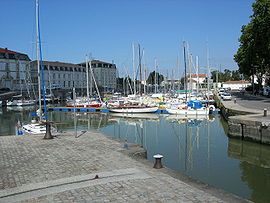Rochefort-sur-Mer
| Rochefort | ||
|---|---|---|
 |
||
|
||
| Coordinates: 45°56′32″N 0°57′32″W / 45.9421°N 0.9588°WCoordinates: 45°56′32″N 0°57′32″W / 45.9421°N 0.9588°W | ||
| Country | France | |
| Region | Nouvelle-Aquitaine | |
| Department | Charente-Maritime | |
| Arrondissement | Rochefort | |
| Canton | Rochefort | |
| Intercommunality | Pays Rochefortais | |
| Government | ||
| • Mayor (2008–2014) | Bernard Grasset | |
| Area1 | 21.95 km2 (8.47 sq mi) | |
| Population (2008)2 | 25,676 | |
| • Density | 1,200/km2 (3,000/sq mi) | |
| Time zone | CET (UTC+1) | |
| • Summer (DST) | CEST (UTC+2) | |
| INSEE/Postal code | 17299 /17300 | |
| Elevation | 0–29 m (0–95 ft) (avg. 5 m or 16 ft) |
|
|
1 French Land Register data, which excludes lakes, ponds, glaciers > 1 km² (0.386 sq mi or 247 acres) and river estuaries. 2Population without double counting: residents of multiple communes (e.g., students and military personnel) only counted once. |
||
1 French Land Register data, which excludes lakes, ponds, glaciers > 1 km² (0.386 sq mi or 247 acres) and river estuaries.
Rochefort (French: [ʁɔʃ.fɔʁ]) is a commune in southwestern France, a port on the Charente estuary. It is a sub-prefecture of the Charente-Maritime department.
In December 1665, Rochefort was chosen by Jean-Baptiste Colbert as a place of "refuge, defense and supply" for the French Navy. The Arsenal de Rochefort served as a naval base and dockyard until it closed in 1926.
In September 1757, Rochefort was the target of an ambitious British raid during the Seven Years' War.
Another infrastructure of early Rochefort from 1766 was its bagne, a high-security penal colony involving hard labor. Bagnes were then common fixtures in military harbors and naval bases, such as Toulon or Brest, because they provided free labor. During the Jacobin period of the French Revolution (1790–95), over 800 Roman Catholic priests and other clergy who refused to take the anti-Papal oath of the "Civil Constitution of the Clergy" were put aboard a fleet of prison ships in Rochefort harbor, where most died due to inhumane conditions.
...
Wikipedia



